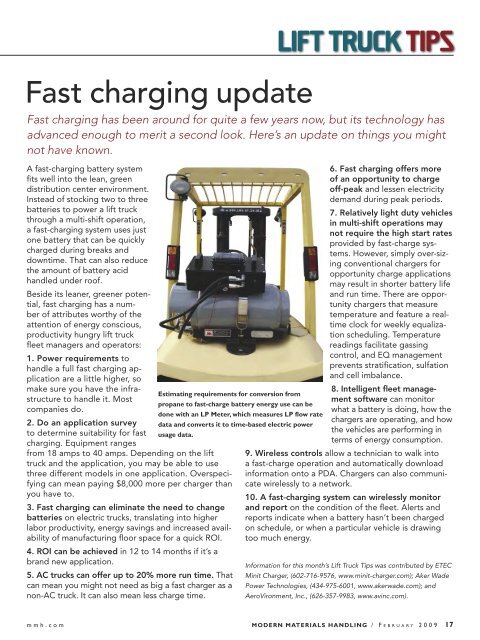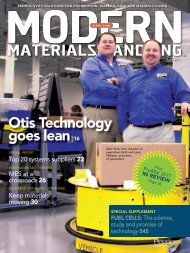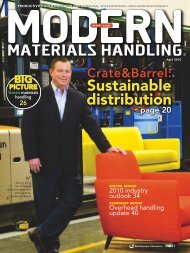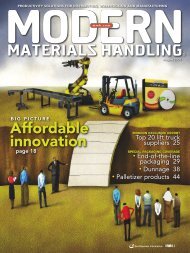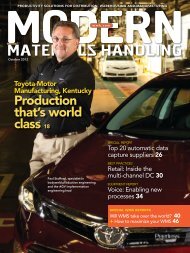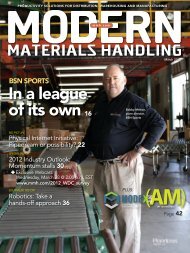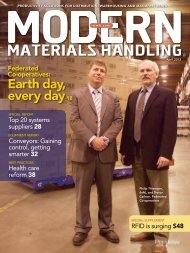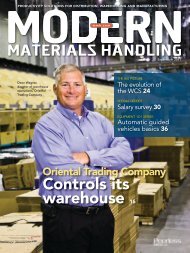February - Modern Materials Handling
February - Modern Materials Handling
February - Modern Materials Handling
- No tags were found...
You also want an ePaper? Increase the reach of your titles
YUMPU automatically turns print PDFs into web optimized ePapers that Google loves.
Fast charging updateA fast-charging battery systemfits well into the lean, greendistribution center environment.Instead of stocking two to threebatteries to power a lift truckthrough a multi-shift operation,a fast-charging system uses justone battery that can be quicklycharged during breaks anddowntime. That can also reducethe amount of battery acidhandled under roof.Beside its leaner, greener potential,fast charging has a numberof attributes worthy of theattention of energy conscious,productivity hungry lift truckfleet managers and operators:1. Power requirements tohandle a full fast charging applicationare a little higher, somake sure you have the infrastructureto handle it. Mostcompanies do.2. Do an application surveyto determine suitability for fast usage data.charging. Equipment rangesfrom 18 amps to 40 amps. Depending on the lifttruck and the application, you may be able to usethree different models in one application. Overspecifyingcan mean paying $8,000 more per charger thanyou have to.3. Fast charging can eliminate the need to changebatteries on electric trucks, translating into higherlabor productivity, energy savings and increased availabilityof manufacturing floor space for a quick ROI.4. ROI can be achieved in 12 to 14 months if it’s abrand new application.5. AC trucks can offer up to 20% more run time. Thatcan mean you might not need as big a fast charger as anon-AC truck. It can also mean less charge time.LIFT TRUCK TIPSFast charging has been around for quite a few years now, but its technology hasadvanced enough to merit a second look. Here’s an update on things you mightnot have known.Estimating requirements for conversion frompropane to fast-charge battery energy use can bedone with an LP Meter, which measures LP flow ratedata and converts it to time-based electric power6. Fast charging offers moreof an opportunity to chargeoff-peak and lessen electricitydemand during peak periods.7. Relatively light duty vehiclesin multi-shift operations maynot require the high start ratesprovided by fast-charge systems.However, simply over-sizingconventional chargers foropportunity charge applicationsmay result in shorter battery lifeand run time. There are opportunitychargers that measuretemperature and feature a realtimeclock for weekly equalizationscheduling. Temperaturereadings facilitate gassingcontrol, and EQ managementprevents stratification, sulfationand cell imbalance.8. Intelligent fleet managementsoftware can monitorwhat a battery is doing, how thechargers are operating, and howthe vehicles are performing interms of energy consumption.9. Wireless controls allow a technician to walk intoa fast-charge operation and automatically downloadinformation onto a PDA. Chargers can also communicatewirelessly to a network.10. A fast-charging system can wirelessly monitorand report on the condition of the fleet. Alerts andreports indicate when a battery hasn’t been chargedon schedule, or when a particular vehicle is drawingtoo much energy.Information for this month’s Lift Truck Tips was contributed by ETECMinit Charger, (602-716-9576, www.minit-charger.com); Aker WadePower Technologies, (434-975-6001, www.akerwade.com); andAeroVironment, Inc., (626-357-9983, www.avinc.com).mmh.com MODERN MATERIALS HANDLING / FEBRUARY 2009 17


